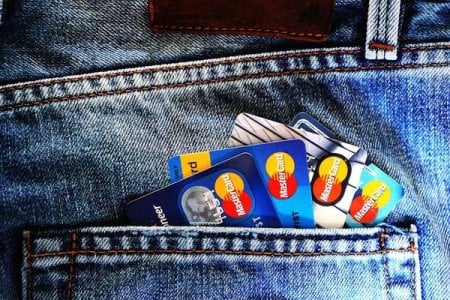Mastercard is dropping card numbers—here's why it could change the way you pay forever
By
Maan
- Replies 0
Recent changes in the world of finance are about to shake up the way we handle payments—and it's not just a small tweak.
What was once considered the standard for card security is now being challenged by a move that could completely redefine your shopping experience.
This shift could have far-reaching implications, from the way we make everyday purchases to the very nature of our financial security.
Mastercard announced a plan to eliminate the 16-digit numbers from debit and credit cards by 2030 in a bid to fight identity theft and card fraud.
This change involves replacing the traditional card numbers with tokenisation and biometric authentication.
In 2022, Mastercard began offering biometric payment options, allowing transactions with a smile or a wave of the hand.
Tokenisation converts the 16-digit card number into a unique token stored on a device, ensuring that card information is never shared when making payments.
AMP Bank will be the first to roll out these numberless cards, with other banks expected to follow within the next year.
In 2023 to 2024, card fraud in Australia reached $868 million, up from $677.5 million the previous year.
Fraudsters often gain access to card details through data breaches, putting consumers at risk.
Late in 2024, a significant data breach affected over 300 million customers worldwide, including from Marriott and Starwood Hotels.
Similarly, Ticketmaster’s breach exposed hundreds of millions of customers' personal and payment details.
Card-not-present fraud, which accounts for 92 per cent of card fraud in Australia, saw a 29 per cent rise in the last financial year.
The Card Verification Value (CVV) system was designed to ensure the person making a transaction physically held the card, but it has proven ineffective.
By removing the card number, Mastercard aims to stop fraudsters from processing unauthorised transactions.
This change also reduces the damage caused by data breaches, as sensitive information is no longer stored.
The 2022 Optus data breach exposed personal information from customers who held accounts back in 2018.
By eliminating the need for companies to store payment details, Mastercard aims to mitigate the risks of future breaches.
However, this shift to a tokenisation and biometric system raises some concerns, particularly for seniors and those with disabilities.
Many older consumers do not use mobile banking, potentially excluding them from the new protections.

While tokenisation strengthens security, it shifts the vulnerability to mobile phones and telecommunication providers.
Criminals already exploit phone-based attacks such as mobile porting and impersonation scams, and these risks could increase.
Biometric data, unlike card numbers, cannot be changed once exposed in a data breach.
This makes biometric data a prime target for attackers, raising concerns over the long-term implications of such data theft.
Biometric breaches, though less frequent, have occurred—such as the BioStar 2 breach in the UK, which exposed fingerprints and facial recognition data of over one million people.
In Australia, Outabox reportedly exposed the facial recognition data of over one million individuals.
With the rise of smartphone payments, the need for physical debit and credit cards has diminished.
In 2023, mobile wallet payments grew by 58 per cent, reaching $146.9 billion in Australia.
More than 44 per cent of payments were made via ‘device-present’ transactions in October 2024.
Amazon's 'Just-Walk-Out' technology, now used in over 70 stores, eliminates the need for physical cards by using cameras and sensors to process purchases.
This innovative technology has been adopted by various vendors, including Trigo, Cognizant, and Grabango, and is being tested by major retailers like Tesco and ALDI.
Even though 'Just-Walk-Out' technology removes the need to swipe or tap cards, consumers still need to enter card details into an app.
To fully eliminate the need for physical cards, smart retail tech providers are looking to biometric alternatives, such as facial recognition payments.
Given the rapid advancement of smart retail technology, it's likely that physical credit cards—numberless or not—will soon become obsolete.
Gary Mortimer noted that we might be heading towards a future without physical cards in Australia.
In a previous story, we explored how Australian banks are stepping up their security measures to combat credit card scams.
Wondering how these updates could further protect your finances? Find out here.

As technology continues to evolve, it’s clear that the way we pay could look vastly different in the near future.
With biometric security on the rise, will we see the end of physical cards altogether? Share your thoughts in the comments!
What was once considered the standard for card security is now being challenged by a move that could completely redefine your shopping experience.
This shift could have far-reaching implications, from the way we make everyday purchases to the very nature of our financial security.
Mastercard announced a plan to eliminate the 16-digit numbers from debit and credit cards by 2030 in a bid to fight identity theft and card fraud.
This change involves replacing the traditional card numbers with tokenisation and biometric authentication.
In 2022, Mastercard began offering biometric payment options, allowing transactions with a smile or a wave of the hand.
Tokenisation converts the 16-digit card number into a unique token stored on a device, ensuring that card information is never shared when making payments.
AMP Bank will be the first to roll out these numberless cards, with other banks expected to follow within the next year.
In 2023 to 2024, card fraud in Australia reached $868 million, up from $677.5 million the previous year.
Fraudsters often gain access to card details through data breaches, putting consumers at risk.
Late in 2024, a significant data breach affected over 300 million customers worldwide, including from Marriott and Starwood Hotels.
Similarly, Ticketmaster’s breach exposed hundreds of millions of customers' personal and payment details.
Card-not-present fraud, which accounts for 92 per cent of card fraud in Australia, saw a 29 per cent rise in the last financial year.
The Card Verification Value (CVV) system was designed to ensure the person making a transaction physically held the card, but it has proven ineffective.
By removing the card number, Mastercard aims to stop fraudsters from processing unauthorised transactions.
This change also reduces the damage caused by data breaches, as sensitive information is no longer stored.
The 2022 Optus data breach exposed personal information from customers who held accounts back in 2018.
By eliminating the need for companies to store payment details, Mastercard aims to mitigate the risks of future breaches.
However, this shift to a tokenisation and biometric system raises some concerns, particularly for seniors and those with disabilities.
Many older consumers do not use mobile banking, potentially excluding them from the new protections.

Concerns grow over technology shifts for seniors and the disabled. Image source: Pexel/Tima Miroshnichenko
While tokenisation strengthens security, it shifts the vulnerability to mobile phones and telecommunication providers.
Criminals already exploit phone-based attacks such as mobile porting and impersonation scams, and these risks could increase.
Biometric data, unlike card numbers, cannot be changed once exposed in a data breach.
This makes biometric data a prime target for attackers, raising concerns over the long-term implications of such data theft.
Biometric breaches, though less frequent, have occurred—such as the BioStar 2 breach in the UK, which exposed fingerprints and facial recognition data of over one million people.
In Australia, Outabox reportedly exposed the facial recognition data of over one million individuals.
With the rise of smartphone payments, the need for physical debit and credit cards has diminished.
In 2023, mobile wallet payments grew by 58 per cent, reaching $146.9 billion in Australia.
More than 44 per cent of payments were made via ‘device-present’ transactions in October 2024.
Amazon's 'Just-Walk-Out' technology, now used in over 70 stores, eliminates the need for physical cards by using cameras and sensors to process purchases.
This innovative technology has been adopted by various vendors, including Trigo, Cognizant, and Grabango, and is being tested by major retailers like Tesco and ALDI.
Even though 'Just-Walk-Out' technology removes the need to swipe or tap cards, consumers still need to enter card details into an app.
To fully eliminate the need for physical cards, smart retail tech providers are looking to biometric alternatives, such as facial recognition payments.
Given the rapid advancement of smart retail technology, it's likely that physical credit cards—numberless or not—will soon become obsolete.
Gary Mortimer noted that we might be heading towards a future without physical cards in Australia.
Wondering how these updates could further protect your finances? Find out here.
Key Takeaways
- Mastercard plans to eliminate 16-digit card numbers by 2030, replacing them with tokenisation and biometric authentication to fight fraud.
- This shift aims to prevent unauthorised transactions and reduce the impact of data breaches, though it raises concerns for seniors and those with disabilities who may not use digital banking.
- The rise of mobile wallet payments and smart retail technologies like Amazon's 'Just-Walk-Out' suggest physical cards could soon become obsolete, with biometric payments on the horizon.
- While tokenisation strengthens security, concerns over mobile phone vulnerabilities and the permanence of biometric data in case of breaches remain.
As technology continues to evolve, it’s clear that the way we pay could look vastly different in the near future.
With biometric security on the rise, will we see the end of physical cards altogether? Share your thoughts in the comments!








